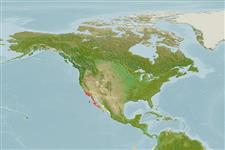Common names from other countries
Teleostei (teleosts) >
Gobiesociformes (Clingfishes) >
Gobiesocidae (Clingfishes and singleslits) > Gobiesocinae
Etymology: Rimicola: Latin, rima, -ae = crack, cleft + Latin, colere = to live.
More on author: Gilbert.
Environment: milieu / climate zone / depth range / distribution range
Ecology
Marine; demersal; depth range 0 - 15 m (Ref. 2850). Subtropical
Eastern Pacific: near San Pedro in southern California, USA to southern Baja California, Mexico.
Size / Weight / Age
Maturity: Lm ? range ? - ? cm
Max length : 5.7 cm TL male/unsexed; (Ref. 2850)
Short description
Morphology | Morphometrics
Adults occur in the intertidal and shallow subtidal to 15 m depth (Ref. 2850). Feed almost exclusively on tiny crustaceans (Ref. 4930). Oviparous, with planktonic larvae (Ref. 36496). Eggs are demersal attached to stones or cobbles (Ref. 36496).
Life cycle and mating behavior
Maturity | Reproduction | Spawning | Eggs | Fecundity | Larvae
Eschmeyer, W.N., E.S. Herald and H. Hammann, 1983. A field guide to Pacific coast fishes of North America. Boston (MA, USA): Houghton Mifflin Company. xii+336 p. (Ref. 2850)
IUCN Red List Status (Ref. 130435)
CITES (Ref. 128078)
Not Evaluated
Threat to humans
Harmless
Human uses
More information
Age/SizeGrowthLength-weightLength-lengthLength-frequenciesMorphometricsMorphologyLarvaeLarval dynamicsRecruitmentAbundance
ReferencesAquacultureAquaculture profileStrainsGeneticsElectrophoresesHeritabilityDiseasesProcessingMass conversion
Tools
Warning: mysqli::__construct(): (HY000/1040): Too many connections in /var/www/html/includes/speciessummary.lib.php on line 2414
Can't connect to MySQL database fbquizv2. Errorcode: Too many connections
